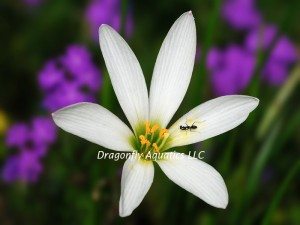 As we get ready for another season, Dragonfly Aquatics is currently working on adding some new plants for the 2010 season. In the upcoming weeks we will be announcing our new plant varieties.
As we get ready for another season, Dragonfly Aquatics is currently working on adding some new plants for the 2010 season. In the upcoming weeks we will be announcing our new plant varieties.
The first we've added are our new Lotus for 2010. The Penelope and Double Rose. The Penelope is a pure white lotus and the Double Rose is a pink full lotus. Both are a great addition to our store. You can find more information on them on our site. https://www.dragonflyaquatics.com/lotus.html
The newest bog plant we've added this year is the Rain Lily or Zephyranthes candida. They have six-petaled flowers that are 1-3 inches across with grassy foliage and grow 3 - 10 inches tall. They grow in full sun to part shade in moist soil or water to 3 inches deep. They are a tender perennial bulbs and hardy in Zone 8 and up. They have however, survived in Zones 5 or 6. You can winter these over by taking them indoors. Just don't water them until you return them to the pond in the spring. They go dormant in the dry season and grow and flower in the wet season.
You can purchase Rain Lilies here on sale through end of March, 2010.
There is nothing better in late winter, than going out to the greenhouses and seeing all the bog plants growing and some of the tropical water lilies starting to bloom again. We heat several greenhouses, so most of the plants we sell are available year round. But, as the days get longer and there is more daylight, the plants really start to take off. A few of the iris are starting to bloom here and there. Before we know it the 2010 shipping season will be in full swing. I can't wait to hear from all our pond friends across the country again. Looking forward to another great season helping people with their pond and plant questions.
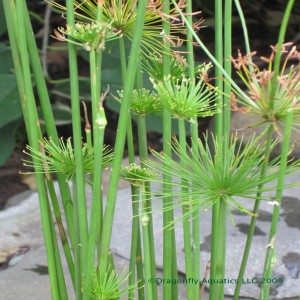 Dwarf Papyrus is a perfect plant for tub gardens or table top container ponds. While the dwarf is a perfect smaller plant for container gardening or smaller ponds if you have a large pond you might want to stick with the larger variety, Dwarf Giant Papyrus which grows about 3 ft tall.
Dwarf Papyrus is a perfect plant for tub gardens or table top container ponds. While the dwarf is a perfect smaller plant for container gardening or smaller ponds if you have a large pond you might want to stick with the larger variety, Dwarf Giant Papyrus which grows about 3 ft tall.
Our Dwarf Papyrus are really nice plants this year. Each now approximately 12" high. This plant is compact with tight tufts of green strands on top of the stems. Height 12-18 inches and spread about 6-12 inches. It requires sun to part shade and moist soil or water up to 4 inches deep.
Dwarf Papyrus is viviparous and will grow new plants from the tops. You can easily winter this plant over indoors as a houseplant in a sunny spot as long as you keep the soil moist at all times but don't submerge the crown. You would want to keep the winter temperature above 50 degrees.
Buy Dwarf Papyrus,bog plant here.
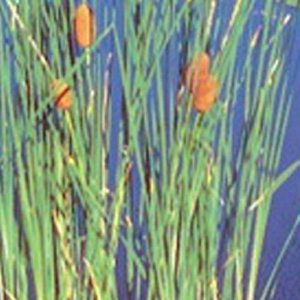 Dwarf Cattails are popular with most of our customers. They are ideal for smaller ponds and container water gardens as well as the regular ponds. They grow in sun to part shade in moist soil or water to just 5 inches deep. Dwarf cattails grow to only about 36 inches in height and do well in Zones 3-10 and will tolerate water over their crown. The foliage on the dwarf cattail is very narrow and it has small catkins. Cattails can be grown from seed, but they propagate quickly from dividing their rhizomes.
Dwarf Cattails are popular with most of our customers. They are ideal for smaller ponds and container water gardens as well as the regular ponds. They grow in sun to part shade in moist soil or water to just 5 inches deep. Dwarf cattails grow to only about 36 inches in height and do well in Zones 3-10 and will tolerate water over their crown. The foliage on the dwarf cattail is very narrow and it has small catkins. Cattails can be grown from seed, but they propagate quickly from dividing their rhizomes.
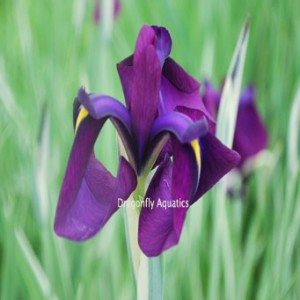 Once your hardy marginal plants begin to brown, usually after the first hard frost, prune back excess foliage and discard any decaying material, so it does not compromise the water quality over the winter months. Potted bog plants such as Pickerel, Thalia Dealbata, and Japanese Variegated Iris should be placed at a sufficient depth to avoid freezing the crown of the plant. Most of the other hardy bog plants can be left as they are and will return the following spring.
Once your hardy marginal plants begin to brown, usually after the first hard frost, prune back excess foliage and discard any decaying material, so it does not compromise the water quality over the winter months. Potted bog plants such as Pickerel, Thalia Dealbata, and Japanese Variegated Iris should be placed at a sufficient depth to avoid freezing the crown of the plant. Most of the other hardy bog plants can be left as they are and will return the following spring.
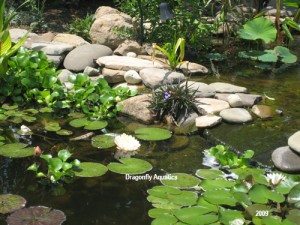 As any gardener knows, after the planting is finished there is always work to be done in the garden. I recently had some little white bugs on my Spider Lily and thought I would share my remedy for this.
As any gardener knows, after the planting is finished there is always work to be done in the garden. I recently had some little white bugs on my Spider Lily and thought I would share my remedy for this.
There are alot of products on the market for killing aphids that sometimes find our plants in the water garden. I use a mixture of soap and water to spray mine which seems to work for me rather than purchasing a product on the market. This is natural and won't harm your plants, fish or water.
1 Tbl liquid dish soap and 1 cup oil. Mix this together and then take 1 tsp of this mixture and add it to 1 qt of water and put it into a spray bottle. You don't want to do this during the hot sunny day but during the evening or early morning when its cooler. Its never a good idea to treat any plant during the heat of the day.
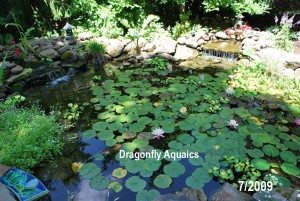 There are some essential tasks to take care of during the summer while enjoying your pond. Water plants can outgrow their containers during the warm summer months. If your waterlilies are covering too much pond surface, simply prune outer leaves of the lily down to half their spread. You will want to remove dead lily pads and spent flowers. These not only create an unsightly appearance but decaying matter will create other problems in your pond.
There are some essential tasks to take care of during the summer while enjoying your pond. Water plants can outgrow their containers during the warm summer months. If your waterlilies are covering too much pond surface, simply prune outer leaves of the lily down to half their spread. You will want to remove dead lily pads and spent flowers. These not only create an unsightly appearance but decaying matter will create other problems in your pond.
If your submerged plants have grown to the surface of the pond, you will want to cut them back so the plants are 6 to 10 inches below the water surface. Anacharis and hornwort can be netted out, cutting back from the bottom of the plant as the top of the plant is the growing portion. Attach a new lead weight and simply toss them back into the pond or repot in pots of pea gravel.
Marginal plants, bog plants and floating plants can all be trimmed of old, brown growth. Don't be afraid to trim back or discard part of any plant that might be taking over your pond. You need to have an area of pond surface open to sunlight for oxygen exchange.
Water plants will grow quickly during the warm weather. Fertilize them with Highland Rim Aquatic Fertilizer Tablets every few weeks, instead of monthly, to encourage them to grow and bloom, putting on a fantastic show.
If some of your water plants require more than a trim, there is still time before fall to divide them. Fall is too late to divide some plants, especially if you live in a cooler climate. They need time and warmth to grow a new root system, before going dormant for the winter.
Now, I'm going out to practice what I preach! As you can see from the photo, I have a few hours of work to do! My lilies and submerged plants are covering most of the surface area in my pond. I will post a new picture, once I have things back under control.
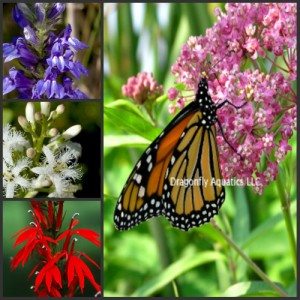 I've been wanting to write something on this subject for some time now. Finally, I have a bit of time to address the subject of water depth for bog plants and marginal plants. Simply put, bog plants like their "feet" wet. Translation....roots and soil moist at all times. When the plants are first planted, this is especially important. Many of the bog plants will take deeper water as they mature and spread. But, when you first receive your bog plants, you will have better success if you place them where there is no more than a half inch or less of water above the soil line. Think of the marshes and swampy areas, you have passed while traveling down the road. These natural reservoirs, fill during the rainy season and will dry out during dry spells. The plants adjust to the varying water depth and grow and spread rapidly. If you have a question on a particular plant, just ask and we will be happy to help you plant and grow beautiful marginal and bog plants.
I've been wanting to write something on this subject for some time now. Finally, I have a bit of time to address the subject of water depth for bog plants and marginal plants. Simply put, bog plants like their "feet" wet. Translation....roots and soil moist at all times. When the plants are first planted, this is especially important. Many of the bog plants will take deeper water as they mature and spread. But, when you first receive your bog plants, you will have better success if you place them where there is no more than a half inch or less of water above the soil line. Think of the marshes and swampy areas, you have passed while traveling down the road. These natural reservoirs, fill during the rainy season and will dry out during dry spells. The plants adjust to the varying water depth and grow and spread rapidly. If you have a question on a particular plant, just ask and we will be happy to help you plant and grow beautiful marginal and bog plants.
There are five different types of plants that you will want to add to your pond to provide beauty and help you achieve an ecological balance in your water garden.
Submerged plants such as Anacharis, Vallisneria, Cabomba, Hornwort and Red Ludwigia remove nutrients from the water so algae can’t thrive. Submerged plants do not need soil. Just plant them in one-gallon pots or plant baskets filled with pea gravel and place them in the bottom of your pond. Or purchase plant anchors with your plant order, and simply wrap the weights around the bunch of plants and they will sink to the bottom of the pond.
Water Hyacinth, Water Lettuce, Frog Bit, Parrot’s Feather and Azolla are all members of the floating plant family. Floating plants are very useful in keeping the pond water clean and clear. These are simple plants that free-float and do not need to be potted. You simply toss them into the water garden where they are extremely beneficial to the pond. Floating plants shade the surface and with their roots dangling in the water they pull nutrients from the water essentially starving the algae. They tend to be quite prolific and provide hiding places for baby fish and other water garden inhabitants.
Otherwise known as water lilies, they grow in pots placed 12 to 36 inches deep and have foliage and flowers that bloom on top of the water’s surface. Water lilies provide shade for the fish and add coverage to the water’s surface. Water lilies are available in many different colors and sizes.
Lotus are also considered a hardy water plant that can also be planted deep in your pond and its flowers and leaves will help provide shade and coverage.
Plants such as the hardy canna (Thalia dealbata) grow in mud or 8 to 12 inches deep in the water. Arrange them on platform shelves on the edge of your pond to conceal the water garden’s artificial edges. Plant bog and marginal plants in plastic pots, then place the pot under the water and let the plants grow in the open air. When the plants are young, use care and gradually lower them deeper as the plant matures.
Bog Plants and Marginal Plants
Marginal and bog plants grow in damp soil just outside a pond. They are good transition plants between land and water. Some tolerate completely waterlogged ground and others will not tolerate more than moist soil, check each plant’s requirements carefully.